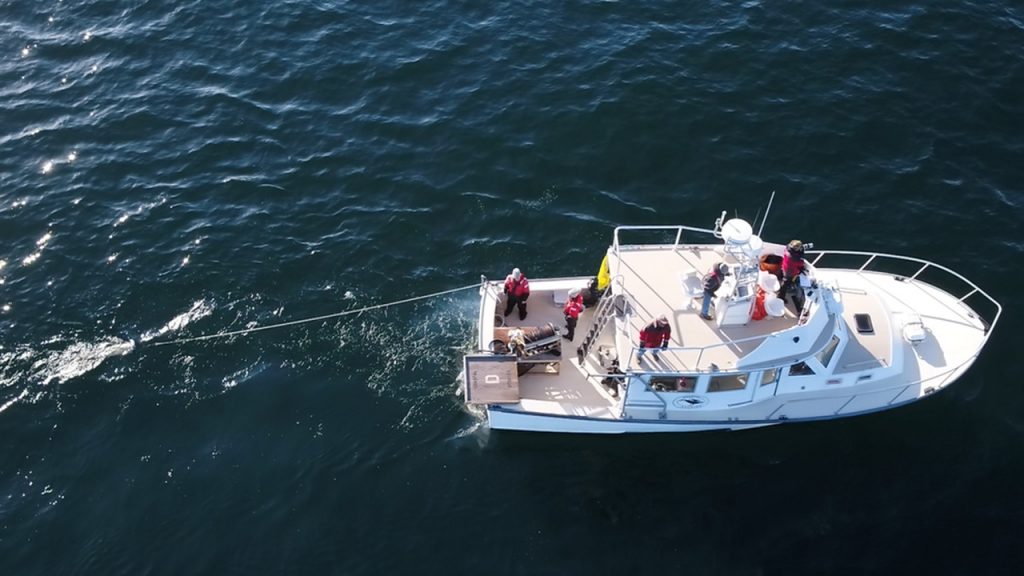In a constantly changing ocean, how can we understand how the myriad of threats faced by marine mammals affects their lives? This is the driving question behind Population Consequences of Multiple Stressors (PCoMS), a collaborative working group that aims to understand the impact of multiple stressors on the long-term health of marine mammals. The group has undertaken three case studies focused on species experiencing a wide variety of threats. These populations include: Barataria Bay bottlenose dolphins, northern elephant seals, and North Atlantic right whales.
In particular, North Atlantic right whales (NARWs) face complex challenges. These whales are highly endangered, with fewer than 350 individuals remaining. They were hunted to near extinction, as they were the “right” whales to hunt. They have also been experiencing an Unusual Mortality Event since 2017, as more than 20% of the population continues to be affected by serious illness, injury, or death.

Because they forage in coastal waters, North Atlantic right whales are especially susceptible to human stressors and have garnered the nickname of the “urban whale.” Vessel strikes are one of the main threats to right whales, as their habitat and migratory routes directly overlap with shipping lanes. Entanglement with fishing gear is another major stressor– it’s estimated that over 85% of right whales have been entangled in fishing gear at least once (NOAA). Other threats include insufficient prey availability, which decreases the number of successful pregnancies and the ability to fight disease, and noise pollution, which impairs communication. In addition, the threat of climate change appears to be leading NARWs to shift their habitat use patterns, which has resulted in contact with new stressors. As one of the world’s most endangered whale species, NARWs are incredibly well studied, with a variety of long-term data sets and acoustic recordings. These two factors make this population ideal as a case study on the impact of multiple stressors.
The PCoMS right whale case study is composed of two sub-projects; a large scale study on longitudinal data of NARW health, and a smaller scale study focused specifically within Cape Cod Bay (CCB). MGEL’s Rob Schick and Tina Yack lead a test of whether whales in Cape Code Bay call to attract other whales to large prey patches and whether noise may affect detection of calls that influence foraging.

Their team is working to compile a timeline of acoustic recordings, visual survey data, and prey abundance data to analyze the consequences of noise disturbance and prey availability on call rate and distribution on NARWs within CCB. Together with colleagues at the Center for Coastal Studies and Duke’s Statistics department, the team has recently developed a model to predict the distribution of NARW prey within CCB and have a manuscript in review.
All recorded noise data is sourced from 13 years of acoustic recorders deployed by Cornell University. Instead of tackling all of this data at once, the team created a test dataset of 17 days for which all forms of data were represented. Using this subset, they are determining the best way to automate analysis for the remaining data. The team is using the acoustic analysis software PAMGuard, developed by Doug Gillespie (Sea Mammals Research Unit, University of St. Andrews), which processes the sound recordings. PAMGuard has algorithms to detect and classify NARW “upcalls,” a contact call that can be used as a proxy for presence of the species. The software also has modules to measure ambient noise, allowing the team to quantify noise levels, which they can compare to call rates and ultimately assess how the whales use the Bay. The team is also using algorithms to localize individuals, pinpointing the location of the whale by its call.
This work has lent itself to a variety of other projects on the specifics of upcall detection, some of which have been driven by Duke undergraduates. Nick Kaney, a senior at Duke, is leading research to compare the performance of different detection and classification algorithms. The team is also looking into how call rate, background noise, and source levels affect detection of upcalls. In addition, Schick and Yack are working with colleagues in the statistics department to develop a model that uses both the acoustic data as well as aerial sightings data to better inform spatially explicit estimates of abundance in CCB.
Six institutions and organizations are involved in the right whale PCoMS case study: Duke’s Marine Geospatial Ecology Lab, University of St. Andrews, Woods Hole Oceanographic Institution, New England Aquarium, Center for Coastal Studies, and Cornell University. The project is funded by the U.S. Department of Defense’s Strategic Environmental Research and Development Program (RC20-1097, RC20-7188/RC21-3091) and the US Office of Naval Research.
All of PCoMS’s work to understand the confluence of stressors in the oceans and their combined effect on marine mammal populations will only become more important as shipping, fishing, and human presence in the ocean continue grow, increasing threats to marine mammals and emphasizing the need for more adaptive management strategies.

